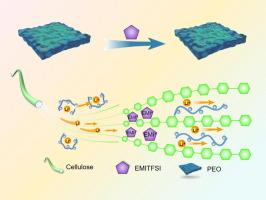当前位置:
X-MOL 学术
›
Chem. Eng. J.
›
论文详情
Our official English website, www.x-mol.net, welcomes your
feedback! (Note: you will need to create a separate account there.)
Design of cellulose/polyethylene oxide/EMITFSI-based composite electrolyte with synergistic transport mechanism for high-performance solid-state lithium batteries
Chemical Engineering Journal ( IF 13.3 ) Pub Date : 2024-11-19 , DOI: 10.1016/j.cej.2024.157790 Jicheng Shan, Jun Song, Xuerong Wang, Bin Li, Haijing Zhu, Xiaosheng Qian
Chemical Engineering Journal ( IF 13.3 ) Pub Date : 2024-11-19 , DOI: 10.1016/j.cej.2024.157790 Jicheng Shan, Jun Song, Xuerong Wang, Bin Li, Haijing Zhu, Xiaosheng Qian

|
Despite its theoretically high energy density, polymer solid-state lithium batteries (PSSLBs) exhibit lower actual energy density. This discrepancy arises from the low ionic conductivity of the polymer solid-state electrolyte (PSSE) due to the coupling of lithium ion (Li+) transport to the relaxation of polymer chain segments. The objective of this study is to optimize the Li+ transport in PSSE. This is achieved by incorporating 1-ethyl-3-methylimidazolium bis(trifluoromethylsulfonyl)imide (EMITFSI) to plasticize both cellulose and polyethylene oxide (PEO). By leveraging the synergistic effects of cellulose and PEO, an ion-conducting network is established. This network allows Li+ to form multiple Li-O coordination simultaneously with the hydroxyl group (OH) of cellulose and the ether group (EO) of PEO, thereby enabling Li+ to transport between the two polymers in a decoupled manner. The PSSE demonstrated an ionic conductivity of 4 × 10-4 mS/cm (at room temperature) and a Li+ transference number of 0.43, significantly exceeding traditional PEO-based values of 10-5 mS/cm and 0.1–0.2. Additionally, the high voltage stability of EMITFSI extends the electrochemical stability window of PSSE, achieving a stability window of 5 V. The assembled LiFePO4/Li cell achieved a specific capacity of 138 mA h/g at 50℃ (0.5C) with a capacity retention rate of 80 % after 280 cycles. This represents an innovative method for preparing high-energy–density solid-state lithium batteries.
中文翻译:

具有协同输运机制的纤维素/聚环氧乙烷/EMITFSI 基复合电解质在高性能固态锂电池中的设计
尽管理论上聚合物固态锂电池 (PSSLB) 的能量密度很高,但实际能量密度较低。这种差异是由于锂离子 (Li+) 传输与聚合物链段松弛的耦合导致聚合物固态电解质 (PSSE) 的低离子电导率引起的。本研究的目的是优化 PSSE 中的 Li+ 转运。这是通过掺入 1-乙基-3-甲基咪唑鎓双(三氟甲基磺酰基)酰亚胺 (EMITFSI) 来塑化纤维素和聚环氧乙烷 (PEO) 来实现的。通过利用纤维素和 PEO 的协同效应,建立了离子传导网络。该网络允许 Li+ 与纤维素的羟基 (OH) 和 PEO 的醚基 (EO) 同时形成多个 Li-O 配位,从而使 Li+ 能够以解耦的方式在两种聚合物之间传输。PSSE 的离子电导率为 4 × 10-4 mS/cm(在室温下),Li+ 迁移数为 0.43,明显超过传统的基于 PEO 的值 10-5 mS/cm 和 0.1-0.2。此外,EMITFSI 的高电压稳定性扩展了 PSSE 的电化学稳定性窗口,实现了 5 V 的稳定性窗口。组装的 LiFePO4/Li 电池在 50°C (0.5C) 时达到 138 mA h/g 的比容量,280 次循环后容量保持率为 80%。这代表了一种制备高能量密度固态锂电池的创新方法。
更新日期:2024-11-19
中文翻译:

具有协同输运机制的纤维素/聚环氧乙烷/EMITFSI 基复合电解质在高性能固态锂电池中的设计
尽管理论上聚合物固态锂电池 (PSSLB) 的能量密度很高,但实际能量密度较低。这种差异是由于锂离子 (Li+) 传输与聚合物链段松弛的耦合导致聚合物固态电解质 (PSSE) 的低离子电导率引起的。本研究的目的是优化 PSSE 中的 Li+ 转运。这是通过掺入 1-乙基-3-甲基咪唑鎓双(三氟甲基磺酰基)酰亚胺 (EMITFSI) 来塑化纤维素和聚环氧乙烷 (PEO) 来实现的。通过利用纤维素和 PEO 的协同效应,建立了离子传导网络。该网络允许 Li+ 与纤维素的羟基 (OH) 和 PEO 的醚基 (EO) 同时形成多个 Li-O 配位,从而使 Li+ 能够以解耦的方式在两种聚合物之间传输。PSSE 的离子电导率为 4 × 10-4 mS/cm(在室温下),Li+ 迁移数为 0.43,明显超过传统的基于 PEO 的值 10-5 mS/cm 和 0.1-0.2。此外,EMITFSI 的高电压稳定性扩展了 PSSE 的电化学稳定性窗口,实现了 5 V 的稳定性窗口。组装的 LiFePO4/Li 电池在 50°C (0.5C) 时达到 138 mA h/g 的比容量,280 次循环后容量保持率为 80%。这代表了一种制备高能量密度固态锂电池的创新方法。


















































 京公网安备 11010802027423号
京公网安备 11010802027423号